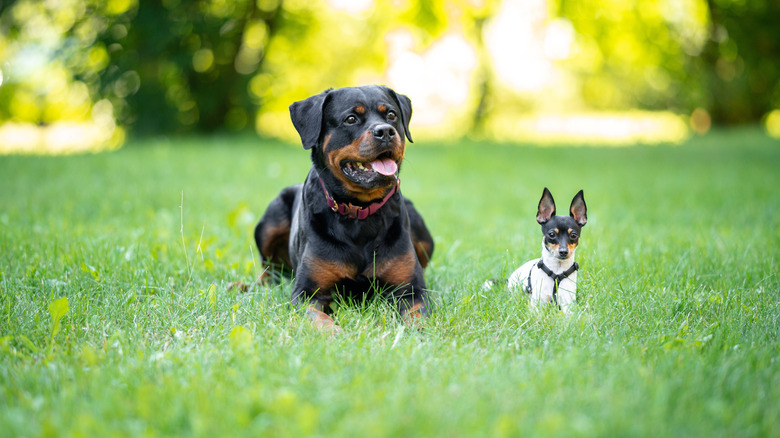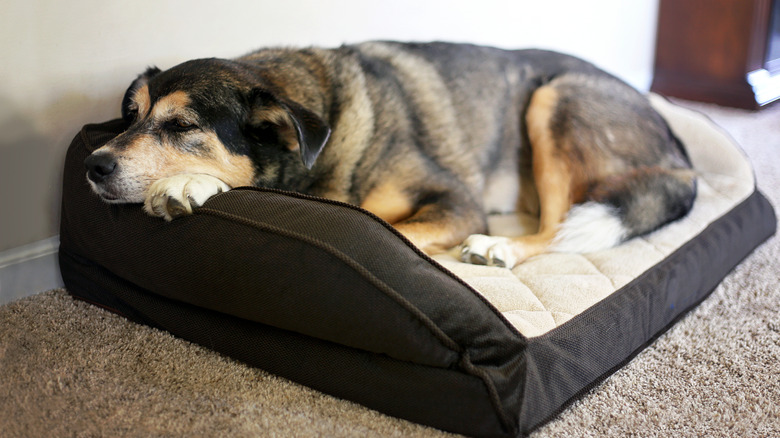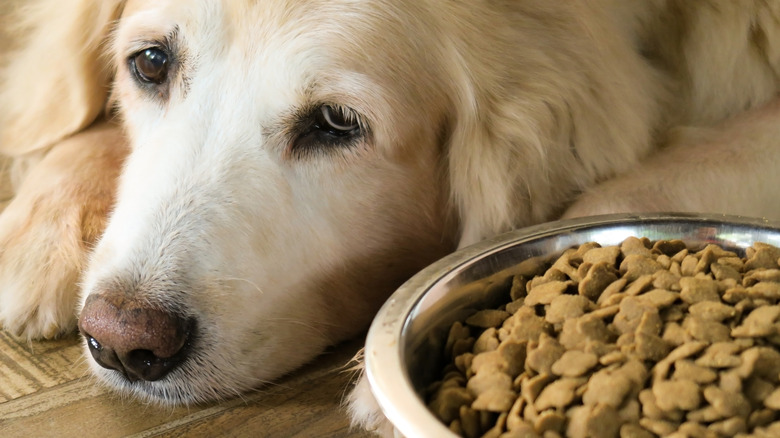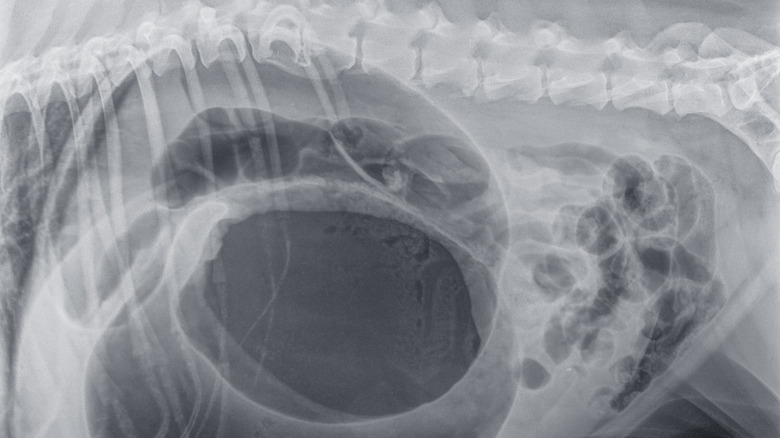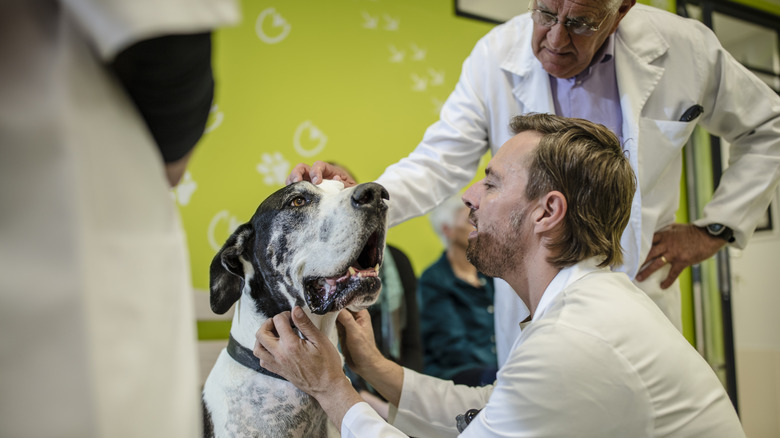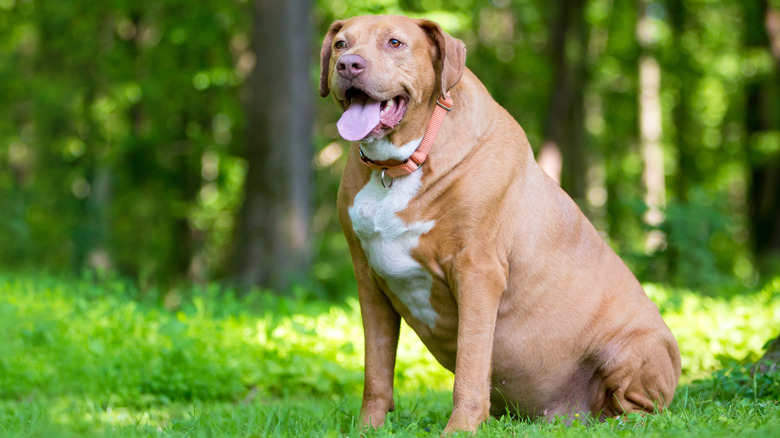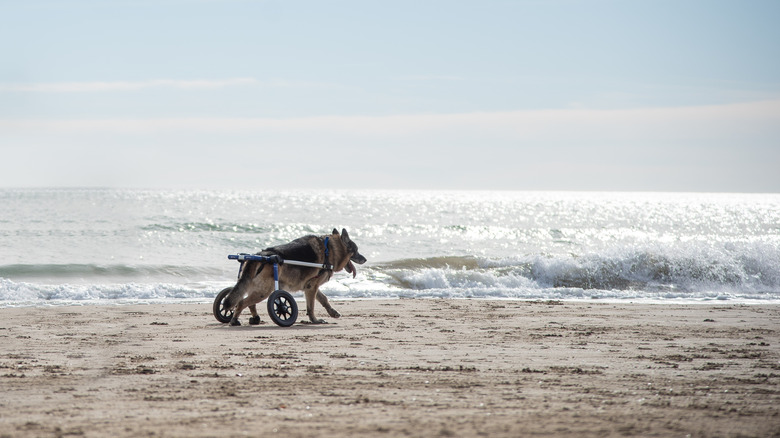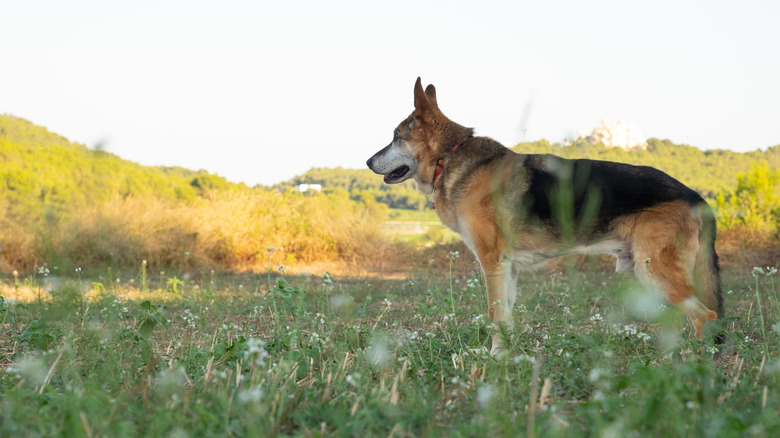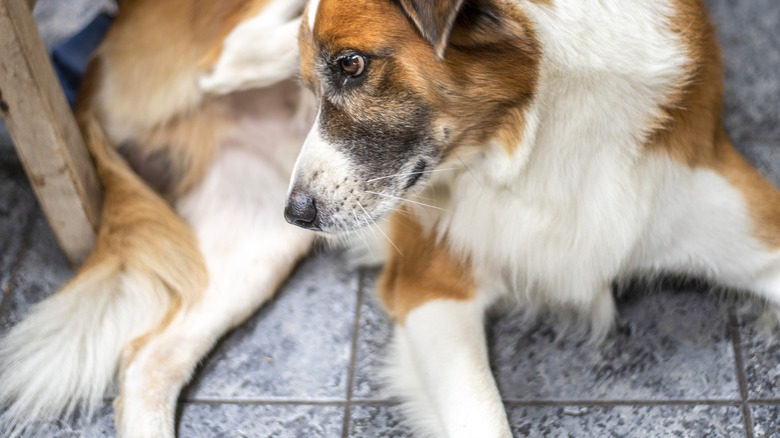Large Dog Breeds Are At Higher Risk Of These 10 Health Conditions
Ask a dozen dog owners about whether big dogs or small dogs are better, and you'll get at least twenty different opinions. Clearly, the bottom line is that whichever dog we love most is the best one for us at that moment. Do you need a small, furry friend who blends easily into an urban life in tight spaces? The cutest small dogs in the world will probably win that contest. Maybe a larger companion for protection, or who can match your pace for outdoor adventures and other sporting endeavors? Sporty, active big dogs for the win!
With that said, it's best to enter into your next canine love affair with a good understanding of what health hurdles your next best buddy might face. If you've fallen in love with a large breed dog, the hurdles they're more likely to face are a little different. As Dr. Gary Richter, founder of Ultimate Pet Nutrition, shared exclusively with Cuteness, a large dog's most common health conditions tend to result from a combination of genetics and biomechanics. "Larger dogs are heavier, so their joints wear faster, which can lead to arthritis, knee injuries, etc.," he explains, adding that poor breeding or overbreeding can amplify certain conditions like dysplasia and degenerative myelopathy.
A 2024 study published in PLOS One on owner-reported data of more than 27,000 dogs also noted that the rapid growth most large-breed dogs experience may be another factor that influences their frequency of orthopedic conditions. Does that mean you shouldn't love a large dog? No — absolutely not! But the better-informed you are about the health challenges your XL-size pup may face, the better-equipped you are to help them live the longest, healthiest life possible.
Arthritis can slow down large dogs
Just like people, arthritis in dogs translates to joint pain and inflammation, and large breeds are much more susceptible than their smaller cousins. If your dog is heavier than it should be, that increases its odds of arthritis, too — which makes this a good time to mention that the aforementioned PLOS One study did note a correlation between dog size and the odds of osteoarthritis. It measured that correlation by weight and found that 30 kilograms, or about 66 pounds, was the dividing line where dogs were slightly more likely to develop arthritis than smaller ones.
As many as one in five dogs may have arthritis during their lifetime. If you notice your formerly active dog becoming reluctant or slow to move, struggling to go up or down stairs and onto the couch, or changing their gait, your vet can help you determine whether arthritis is the root cause. The good news is that a number of helpful therapies are available to help reduce your dog's arthritis-inflicted pain: Treatment options may include medication, supplements, hydrotherapy, acupuncture, and weight control.
Once again sharing their similarity to humans, appropriate levels of physical activity can help stave off arthritis symptoms in dogs, just as they do with people. However, that doesn't mean that human supplements and medications will help your dog. Quite to the contrary, in fact, as they may be toxic for dogs — so make sure you get your vet's okay before dosing your dog with anything that was originally intended for you.
Gastrointestinal problems can cause trouble for larger pups
The same PLOS One study that identified arthritis as being more common in larger dogs also pointed out that larger dog breeds — most notably large and giant breeds over 88 pounds — are more likely than smaller dogs to suffer from gastrointestinal troubles. That's a very broad category, but once you realize that the most common type of GI upset in dogs is what's charmingly known as "dietary indiscretion," — i.e. that living Labrador retriever vacuum — it all starts to make sense.
Those dietary indiscretions are, simply put, the act of eating things they shouldn't — and a big dog has bigger, stronger jaws to help them chow down on the wrong things, from plastic bottles to garbage, poop, and even toys or pieces of clothing, that then irritate or block their digestive tract. Signs that your dog might need medical help due to gastrointestinal problems include constipation, diarrhea, vomiting, hunched-over posture, abdominal distention, yelping if you touch their abdomen, and lack of appetite.
Gastric dilatation volvulus can affect large breeds
One very specific gastrointestinal condition that affects large dogs more than small dogs is gastric dilation volvulus (GDV). This means the dog's stomach fills up with gas like a balloon, then twists on itself so the gas can't exit the stomach in either direction, leading to increased discomfort, and, as you might imagine, an urgent medical emergency.
Veterinarians don't know exactly why, but gastric dilation volvulus seems to be most common in large, deep-chested male dog breeds, such as German shepherds and Great Danes. Calm, relaxed dogs seem to be at less risk of developing GDV, while their higher-strung counterparts are more likely to develop GDV. Again, experts aren't sure exactly why that is.
Symptoms of GDV include unproductive vomiting (dry-heaving or vomiting foam), a bloated stomach, attempting to defecate without success, excessive drooling, panting and pacing, pale gums, and even, ultimately, collapse. If you suspect your dog has GDV, this represents a genuine medical emergency, and you should seek veterinary help immediately. Luckily, steps can be taken to help reduce the chances of GDV in some breeds, such as feeding smaller meals more frequently. Dr. Richter also notes that "prophylactic gastropexy can prevent bloat." This involves tacking the stomach down to prevent it from twisting.
Some cancers can affect specific large breeds
Of all the cancers that are common in dogs, a few certain types are more likely to strike large dogs. Among these, Dr. Richter advises, are hemangiosarcoma and osteosarcoma. A 2023 study conducted and published by the Royal Veterinary College at the University of London, found that osteosarcoma — which destroys normal bone and replaces it with cancerous bone — is much more common in large dogs than other sizes. Some of the most commonly affected breeds include Scottish deerhounds, Leonbergers, Great Danes, and Rottweilers.
Osteosarcoma also (relatively) commonly affects St. Bernards and golden retrievers. Affected bones are much more likely to fracture than healthy bones, and the effects most typically appear in your dog's fore or hind limbs — although the bones in the jaw, ribs, and pelvis are sometimes affected too. While there are some surgical options for treating osteosarcoma, it tends to be a very painful disease, so the most common treatment approach focuses on managing that pain to give your dog the best quality of life possible.
Hemangiosarcoma, another cancer, affects the lining of the blood vessels. It's most commonly seen in the spleen, but can occur anywhere in the body, including the heart, liver, skin, and even the blood vessels inside muscles. It's thought that hemangiosarcoma's relative prevalence in certain breeds — including German shepherds, golden retrievers, and Labrador retrievers — indicates a genetic component to the disease.
Obesity can affect all breeds, especially large ones
Obesity and being overweight increase the odds of your dog experiencing many of the health conditions on this list, and quite a few other health challenges as well. Just a few of the issues that crop up more frequently in obese dogs include arthritis, pancreatitis, kidney disease, and cardiovascular disease. Obese dogs may also struggle to be active or even to breathe, and show a generally decreased quality of life. Although obesity can strike any breed, flat-coated retrievers may be at particular risk due to a genetic mutation.
Golden retrievers, Labrador retrievers, and boxers are among the other large breeds that may be particularly prone to obesity, with some smaller breeds such as cocker spaniels, dachshunds, beagles, and pugs falling into the same general risk category. One could easily argue that any very good dog with a human who enjoys showing their love through treats is also at special risk.
Ultimately, preventing obesity is easier than treating it. Key prevention strategies include striking the right balance between your dog's food intake and its exercise, and staying on top of annual vet visits to identify any conditions that might contribute to obesity. If your dog has packed on a few too many extra pounds, your vet can provide guidance on how best to slowly adjust diet, exercise, and sometimes also medications to bring your pup's body weight back into balance.
Degenerative myelopathy can affect the joints of large dogs
Degenerative myelopathy affects your dog's spinal cord in much the same way Lou Gehrig's disease — more properly known as amyotrophic lateral sclerosis or ALS — affects humans. As the disease progresses, your dog will show increasing weakness and loss of coordination in its limbs, starting with the hind end and sometimes progressing toward the front of the body in the later stages of the disease.
Degenerative myelopathy typically affects dogs that are eight years or older, and is most likely to strike large dog breeds: German shepherds, boxers, Labrador retrievers, Chesapeake Bay retrievers, Siberian huskies, Rhodesian ridgebacks, and Bernese mountain dogs are among those most affected. Degenerative myelopathy is fairly common in some smaller breeds too, including the Pembroke Welsh corgi, Cavalier King Charles spaniels, pugs, and miniature poodles. As you might expect, the prevalence of this disease in certain breeds indicates a genetic, hereditary component.
If you notice clumsiness and weakness in your dog's hind end, this might be an early sign of degenerative myelopathy. It could also be an indicator of other diseases, so it's important that you take your dog to the vet for testing and diagnosis. Although there is no cure for degenerative myelopathy, there are supportive therapies you can use to keep your dog as happy and comfortable as possible. These include physical therapy, hydrotherapy, massage, and the use of a supportive sling or a wheelchair to help keep your dog mobile for as long as possible.
Rupture of the cranial cruciate ligament can injure larger dogs
Just like us, dogs have four major ligaments in their stifles, or knees: Two collateral ligaments that act like straps along the outside of the knee, and two cruciate ligaments that cross inside the knee, joining the femur and tibia together and making the knee work like the hinge it's meant to be. That's right — your dog also has a femur and tibia (and fibula), and even meniscus, inside their knee just like you do.
The cranial cruciate ligament (CCL) in dogs is analogous to the anterior cruciate ligament, or ACL, in humans. Once again, as with humans, injuries to a dog's CCL are common in forceful, twisting injuries — like sudden changes of direction while at a run. However, a dog's CCL can also rupture due to repeated wear and tear caused by progressive small traumas that weaken the joint. Other contributing conditions include arthritis and a luxating patella.
While both small and large dogs can suffer CCL tears, smaller dogs generally have better chances of compensating without surgery to repair the ligament. Larger dogs almost always require surgery to stabilize the knee and prevent further pain and damage. Your vet will help verify the injury and determine the best course of action for your dog, and you may be asked to pitch in with bracing, supportive slings, and other treatments to assist your dog in recovering.
Hip and elbow dysplasia can harm certain large breeds
Hip and elbow dysplasia are abnormal development of those joints, eventually leading to joint deformation, pain, and lameness. Hip dysplasia, in particular, is a common topic among German shepherd owners, as it famously plagues some lines of that breed.
However, numerous other breeds can be susceptible to dysplasia of both hips and elbows, with large dog breeds being at particular risk because of how large they get and how quickly they grow. Saint Bernards, Great Danes, and Labrador retrievers are among the breeds most commonly affected. Both hip dysplasia and elbow dysplasia are hereditary so, if you're in a position to purchase a puppy from an arranged breeding, screening of both parents is vital for ensuring that they don't pass on this ailment to the puppies.
Most people adopting a large-breed puppy (or dog of any age) won't have the option of pre-screening the parents for dysplasia, but there are still a number of things you can do to reduce the odds of a dog developing hip or elbow dysplasia. This includes feeding foods specially formulated to stem excessive growth in large-breed puppies, ensuring the right amount of exercise in growing puppies (not too little and not too much), and keeping your dog at a healthy weight, as dysplasia is one of the many conditions that can be exacerbated by obesity. As always, your vet is the most valuable ally in determining your dog's ideal routines for both food and exercise.
Laryngeal paralysis can affect large dogs
A condition known as laryngeal paralysis can cause your dog to lose function in the nerves that control its larynx or voice box. Laryngeal paralysis may be an early symptom of a more complex syndrome known as geriatric onset laryngeal paralysis and polyneuropathy, or GOLPP; or it can be a symptom of other conditions, including Cushing's disease, hypothyroidism, and endocrine disorders. This condition is most common in older, large-breed dogs, although laryngeal paralysis can also be caused by trauma or manifest as a congenital condition in young dogs.
Some of the large dog breeds you might see laryngeal paralysis in include Labrador retrievers, Dalmatians, Siberian huskies, Rottweilers, and American Staffordshire terriers. Laryngeal paralysis on its own can become a medical emergency as it leads to difficulty breathing, while GOLPP presents the additional complication of difficulty swallowing food and water, which can easily lead to aspiration pneumonia. Although there is no cure for laryngeal paralysis, there are surgical and non-surgical options for managing it throughout your dog's life.
Skin conditions can bother your larger dog
Owners of large dogs report their pets as having skin conditions more frequently than owners of small dogs. Older dogs (of all sizes) are also much more likely to develop skin conditions than young dogs, with toy dogs — that is, the tiniest of tiny dogs — having the lowest prevalence of skin conditions overall.
What does that mean for your big dog with itchy skin? Common skin conditions such as yeast infections, ringworm, and dry skin can seriously affect its comfort and quality of life. Those and other skin problems can also be harbingers of more serious health conditions, including allergies; external parasites like fleas, ticks, and mites; and autoimmune diseases. It's always best to run anything unusual about your dog's skin past your veterinary team, as they can help you identify any underlying conditions and also screen for skin cancer, which does occur in dogs. Luckily, many skin conditions are treatable with management from your vet.
Preventive care can help your large dog have a long, healthy life
While it's true that there are a number of challenging health conditions that may beset a large dog, as the adage goes: Don't borrow trouble. Do inform yourself about what hurdles your big dog may face, but don't let that yank you out of enjoying the moment with your beloved pet. Instead, use your knowledge of what might go wrong to focus on making sure things go as right as possible. That starts with regular preventive visits to your veterinarian.
As Dr. Richter explained to Cuteness, "Regular screening for medical problems can help catch things early, which provides better treatment options and outcomes." He adds that careful timing of a spay/neuter surgery — waiting until the dog is fully physically mature — can help decrease the risk of many health conditions that affect large dogs. The American Animal Hospital Association makes the same recommendation, adding the stipulation that a "large" dog is one that's expected to meet or beat 45 pounds of body weight, and that a large dog's growth often stops around 9 to 15 months of age — making that the prime window for a spay or neuter. Your vet can help you pin down that time more specifically for your dog.
Adjust the frequency of vet visits according to your dog's size
Given that large dogs are more prone to certain conditions, should they go to the vet more frequently? Not necessarily. "Both large and small dogs should have checkups at the same frequency," says Dr. Richter. Numerous veterinary experts provide similar guidance, noting that all dogs should have a preventive vet visit at least once a year, with twice being even better if you can manage it.
"For younger dogs, usually once yearly is fine. As they get older, twice yearly is normally better," explains Dr. Richter. From that baseline frequency, your vet can help you determine whether your dog's specific health conditions warrant more frequent screening or not. Ultimately, age and health, not size, are the determining factors in how frequently your dog needs to be seen.
There's also the challenging reality that not everybody can afford regular preventive vet care. If that's you, please know that you're not alone — and consider touching base with shelters and rescue organizations in your area to see if they can recommend resources. Often, you may find that there are coupons to help defray the cost of veterinary visits, as well as free or inexpensive vaccination clinics for your dog to get shots to forestall vaccine-preventable diseases. After all, the point of those annual visits — and even the simple act of reading up on health conditions your dog might encounter — is ensuring that whatever challenges your large dog may face, they're easier to treat.
Always consult your veterinarian before making changes to your pet's diet, exercise, or care. To find an accredited veterinarian in your area, you can search the American Animal Hospital Association's online database.
